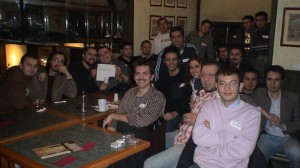-
Microsoft Academic Search
Microsoft Research’in yan ürünü olarak geliştirilen Academic Search’te 5 milyonun üstünde bilgisayar bilimleri ve bilişim teknolojileri ile ilgili bilimsel kağıt, konferans ve dergi makalesi var. Google Scholar ve EBSCO üzerinden bulamadığım veya ücretsiz ulaşamadığım bazı makaleleri bulunca sevindirici oldu. Nasıl olduğunu ise henüz çözemedim. Göze de hitap eden akıcı bir tasarımı var. Logosu da güzel olmuş :) Scholar’dan farklı olan yanı ise sadece bilgisayar bilimleri ile ilgili disiplinlerdeki yayımları bulabilmesi. Ayrıca “citation ranking” de yapıyor.Read more → -
xkcd Random Bookmarklet'i
Şu aralar sınav, ödev, proje, quiz çıldırmacalarında koştururken günümüzün birkaç dakikasını eğlenceyle geçirmeye çalışıyoruz. Güzel de bir deneyim oluyor açıkçası. :)
Can sıkıntısından xkcd adlı geek işi webcomic sitesindeki random düğmesini alıp bookmarks (yer imleri) çubuğuna sürükledim, canım sıkıldıkça tıklıyorum. Siz de tıklayın eğlenin. http://dynamic.xkcd.com/comic/random/
-
Microsoft Silverlight ve SharePoint Seminerleri
TBD Genç Ankara olarak Ankara Üniversitesi’nde 20 Nisan 2010’da Daron Yöndem ve Tayfun Akçay‘ın konuşmacı olarak katılacağı iki oturumluk bir etkinlik düzenliyoruz. Etkinlik Microsoft’un iki güzel teknolojisi Silverlight ve Office Sharepoint hakkında ikişer saatlik eğitimlerden oluşuyor. Ben de Silverlight’ta gelecek görenlerdenim açıkçası. Sadece Windows’ta çalışıyor olması bir negatif olmasına rağmen kullanışlı browser-desktop uygulamalarını pratik bir şekilde oluşturmanıza yardımcı oluyor. Sharepoint ise öğrencilerin pek işlerine yaramayacak, fakat mezun olduklarında enterprise, B2B sektörlerinde çalışacaklar için genellikle aranan bir özellik SharePoint bilgisi.Read more → -
Ankara Yazılım Atölyesi ORM Etkinliği
Ankara Yazılım Atölyesi adı verilen gönüllü geliştiriciler topluluğu, Çankaya Üniversitesi’nde 17 Nisan 2010 Cumartesi – 13:00-17:00 arasında ORM (Object Relational Mapping) temalı aylık seminer etkinliğini düzenliyor. Ben katılmayı düşünüyorum. Java Hibernate ve ADO.NET Entity Framework anlatılacak. Bu aralar NoSQL, Object Relational Database Management System (ORDMBS), Distributed Databases gibi konular trendde iken altyapı (infrastructure) geliştirme konularıyla ilgilenen arkadaşların gitmesini şiddetle öneriyorum. Her ne kadar Çankaya Üniversitesi’ne ulaşım zor olsa da ben gitmeyi düşünüyorum :) Umarım güzel bir 4 saat geçiririz.Read more → -
Ankara'da Blog Yazarları Brunch'ı
[
 İnternet ve Blog Yazarları Derneği](http://www.blog.org.tr) 18 Nisan 2010 Pazar günü saat 11.00′de, Seyir Kafe’nin alt katında öğle kahvaltısı (brunch) düzenliyor. Açık büfe 80 çeşit kahvaltılık ve yemek çeşidinin yanında sınırsız çay, çilek suyu ve portakal suyunun da dahil olduğu bu kahvaltının bedeli 9 TL. Ben katılmayı düşünüyorum. Sizleri de blogosfer insanlarıyla güzel bir Pazar brunch’ı yapmak isterseniz bekleriz. Mekana ulaşım da zor değil. [detaylar]
İnternet ve Blog Yazarları Derneği](http://www.blog.org.tr) 18 Nisan 2010 Pazar günü saat 11.00′de, Seyir Kafe’nin alt katında öğle kahvaltısı (brunch) düzenliyor. Açık büfe 80 çeşit kahvaltılık ve yemek çeşidinin yanında sınırsız çay, çilek suyu ve portakal suyunun da dahil olduğu bu kahvaltının bedeli 9 TL. Ben katılmayı düşünüyorum. Sizleri de blogosfer insanlarıyla güzel bir Pazar brunch’ı yapmak isterseniz bekleriz. Mekana ulaşım da zor değil. [detaylar] -
Sizi Pardus Tanıtım ve Geliştirme Günleri'ne Bekliyoruz!
Yaklaşık 2 aydır durmadan organizasyonu için çalıştığım büyük bir etkinlik var. Kısaca “Pardus Günleri”. Geçen sene Atılım Üniversitesi’nde düzenlenen bu etkinliği bu sene TBD Genç Ankara ve Bilkent IEEE CS organizasyonuyla düzenliyoruz. 23-24 Mart 2010’da saat 12.30-18.00 arasında 2 günde toplam 8 oturum olacak ve 4 etkinliğe katılana “katılımcı belgesi” de verilecek. Çok detaylı ve mükemmel bir etkinlik programımız var. Fakat gelmek istiyorsanız online kayıt yaptırmayı kesinlikle unutmayınız. Etkinliğe gelecekseniz benimle tanışmayı da ihmal etmeyin!Read more → -
Ankara Blog Yazarları Mart 2010 Buluşması
[
 İnternet ve Blog Yazarları Derneği](http://www.blog.org.tr)’nin 14 Mart 2010’da saat 15.00’da Koliba Cafe‘de buluşması olacak.
İnternet ve Blog Yazarları Derneği](http://www.blog.org.tr)’nin 14 Mart 2010’da saat 15.00’da Koliba Cafe‘de buluşması olacak.Geleneksel bir toplantı ve keyifli geçiyor. Blog yazan/yazmayan, Ankara’daki blogcularla tanışmak isteyen herkesi bekleriz. Katılım herkese açıktır, ben de orada olacağım. Gelirseniz beni bulmayı, tanışmayı ihmal etmeyin :)
-
TBD Genç Ankara Genç Bilişimcilerle Buluşuyor
[caption id=“attachment_1150” align=“alignright” width=“300” caption=“TBD Genç Ankara”][/caption] Türkiye Bilişim Derneği’nin Ankara Şubesi altında bir çalışma grubu olarak kurulan TBD Genç Ankara, bilişime meraklı üniversite öğrencileri ve gençleri birlikte çalışmaya davet ediyor. 1971’de kurulan Türkiye Bilişim Derneği, bugün 10.000 kadar üyeye sahip ve devlet kararıyla birlikte “Kamu Yararına Çalışan Dernekler” statüsünü almıştır. TBD Genç ise Ankara, İstanbul, Samsun gibi birkaç şehirde aktif olarak faaliyet göstermekte olan ve TBD’nin üniversite öğrencilerini faydalı amaçlar doğrultusunda örgütlemek amacıyla oluşturduğu çalışma grubudur.Read more → -
mySchoolog'dan Öğrendiklerim
 Hikaye 2007 yılında Web 2.0 kelimesinin Türkiye’de kullanılmaya başlandığı ilk zamanlara dayanıyor. Daha doğrusu ne olduğuna dair mantığın dünyada anlaşıldığı zamanlardan bir yada iki yıl sonrasına… Lise 2’de okuyorum ve Romanya’da uluslar arası bir programlama yarışması olduğunu öğreniyorum. Buna katılmak için bir proje düşünüyorum. O zamanlarda da Ajax gibi teknolojiler revaçta. Bişiy yaparım ben bunla ki düşüncesiyle bir web projesi yapmaya başlıyorum. Konu da öğrencilerin okul hayatlarını internet üzerinden yönetebilmesi için tasarlanan, her yerden erişilebilen, pratik bir web servisi. Sonra mySchoolog doğdu.
Hata 1: Web 2.0’ı yanlış anlamak
Hikaye 2007 yılında Web 2.0 kelimesinin Türkiye’de kullanılmaya başlandığı ilk zamanlara dayanıyor. Daha doğrusu ne olduğuna dair mantığın dünyada anlaşıldığı zamanlardan bir yada iki yıl sonrasına… Lise 2’de okuyorum ve Romanya’da uluslar arası bir programlama yarışması olduğunu öğreniyorum. Buna katılmak için bir proje düşünüyorum. O zamanlarda da Ajax gibi teknolojiler revaçta. Bişiy yaparım ben bunla ki düşüncesiyle bir web projesi yapmaya başlıyorum. Konu da öğrencilerin okul hayatlarını internet üzerinden yönetebilmesi için tasarlanan, her yerden erişilebilen, pratik bir web servisi. Sonra mySchoolog doğdu.
Hata 1: Web 2.0’ı yanlış anlamakWeb 2.0, Web 3.0, Web x.0… ne olduğu hiç fark etmez. Öncelikle metodolojiden ziyade trendin felsefesiyle ilgilenmelisiniz. Fiziksel özellikler çabuk değişir fakat bir trendi ayakta tutan insanların zihniyetidir, kullanıcı alışkanlıklarıdır. Örneğin Web 2.0 dendiğinde akla gelen şeyler aşağı yukarı şunlardı:
-
İçeriği kullanıcı üretecek
-
Güzel bir logo olacak, logonun aşağıya doğru ters ayna görüntüsü olacak
-
Kullanıcılarla iletişim kutucukları pop-up şeklinde açılacak
-
Renkli container’ların ve kutucukların köşeleri yuvarlak olacak
-
10pt-12pt gibi ufak yazılar kullanmak yerine daha kısa öz ve rahat okunabilen yazılar.
-
İçerik etiketleme, içeriğin diğer kullanıcılarla paylaşımı (sosyal ağ mantığı)
-
Sayfa baştan yüklenmeden değişen dinamik içerikler (Ajax)
-
Her web servisinin bir blog’u olacak. Blog olmasa bile çeşitli konularda RSS sağlanacak. Bu tip bir çok web 2.0 karakteristiği mySchoolog’da oldukça güzel bir şekilde uygulanıyordu. Fakat kullanıcıların %90’ının umrunda olmayan şeyler bunlar. Kullanıcı alışkanlıklarını kazanabilen, basitliği ve yüzeyselliği sağlayabilen siteler rakiplerine göre maça önde başlıyorlar. Önemli olan teknik altyapı veya ufak detaylar değil, kullanıcının sistemi niye kullanması gerektiğidir, sistemin uygulanabilirliğidir (fizibilitesidir).
Her şeyden önce uygulanabilir ve tutacak fikri bulmak oldukça önemli.
Hata 2: Az bilgiyle çok iş yapmak
Dönüp mySchoolog yazılımının kaynak kodlarına baktığımda kendim bile anlayamadığım bir sistem mevcut. Öncelikle sistemi kodlayacak yazılımcı(lar)ın kullanacakları programlama diline, veritabanı teknolojilerine hakim olmaları gerek. Yazılımcı, programlama dilinin design pattern’larını (tasarım örüntüleri - arayüz tasarımı ile ilgili bir konu değildir) iyi bilmeli ve piyasadaki en kullanışlı ve proje sürecinde en uygun adaptasyonu sağlayabilecek framework’leri kullanmalıdır. Kullandığı dilde piyasadaki en son gelişmeleri bilmelidir.
Örneğin ben yarım yamalak PHP bilgimle ve MySQL kullanımımla bir sistem ortaya çıkarmıştım fakat sonradan bir çok test yapmak zorunda kaldım. Kimi bug’ı kendim buldum, kimilerini de kullanıcı bildirimleri sayesinde öğrendim. Fakat yazdığım uygulama 10,000 kullanıcıda şimdiye kadar sorun çıkarmasa da aynı anda sitede gezen 50 kişi belki de kaos olacaktı. Bu yüzden eğer altyapı kodlanacaksa işin eri birinin bunu yapması gerek.
Arayüz tasarımı konusu ise başlı başına bir bela idi. Oturup uzman olmadığım XHTML, CSS, JavaScript gibi konularda bir şeyler öğrenmeye çalışarak bir arayüz çıkardım. Hala kendi yaptığım arayüzü (duygusal bağlarımdan ötürü) seviyorum, fakat bir çok tasarımcıya göre tam bir felaket. Birkaç görüntü atraksiyonu yapabilmek için harcadığım o kadar zamanın bugün bana kattığı bilgi açısından boşa gitmediğini düşünüyorum. Ben javascript kütüphanesi olarak prototype+script.aculo.us kullanıyordum fakat bugün jQuery’e eklenen ufak tefek eklentiler benim saatler verip yaptığım ve bug içeren şeyleri neredeyse sorunsuz olarak sunuyolar. Belki de o zaman jQuery’den haberdar değildim, piyasayı iyi araştırmamışım bu benim hatam. Arayüz işini de konuyu bilen yapmalıdır.
Read more → -
-
Contemporary Design Issues in Modern Programming Languages (Modern Programlama Dillerindeki Tasarım Sorunları)
**Design Issues in Modern Programming Languages ** Ahmet Alp Balkan
This essay has been prepared for Programming Languages CS course. It can be freely used and distributed.
 Details of a programming language design is one the most controversial issue in the theory of programming languages. Many years ago, languages designed for programming computers have
Details of a programming language design is one the most controversial issue in the theory of programming languages. Many years ago, languages designed for programming computers havea syntax such that only a machine can understand and translate. Such languages were called “low-level programming languages” and they were not providing any abstraction functionality while coding a new program using these languages. [1] These machine languages are evolved to assembler and many years later we have “high-level programming languages” which sometimes hide all details of computer architecture and language implementation details with abstracting many kinds of functionality. People “create” something when they do need it. With evolution of computers and computer programming, many reasons triggered creation of new programming languages. Most of the time, these reasons are about efficiency, usability, style, functionality (capability) of usage of these programming languages. Let’s say if a company hires a software engineer and request a computer program does a particular job, if engineer would code this program in assembly language, it may take months; on the other side, most probably, it would take a few days using a new-generation programming language. That is about the efficiency and saving money for enterprise market in software engineering. To do particular jobs in computers, labs or people design new programming languages which developers can get rid of unnecessary parts of implementation.
Readability and ease of coding are also reasons behind appearance of new programming languages. Recall from low-level programming languages, the first languages i.e. FORTRAN, ALGOL, COBOL were not consist on good readable codes. This is a big deal since many software is created collaborated today, the code written on a language must be readable easily by other developers as well. However, major languages designed in last 15 years consist on a syntax which is human-friendly. In this issue, it is not all about programming language design but also developers’ coding style. [2] On the other hand language syntax is exactly a limiting factor for code readability. Any code written on a language may not be readable even it has been coded by a pretty good developer. Besides that, collaboration is limited by readability. When Hejlsberg released C# language, one of the important benefit was ease of coding and readability of code.[3]
Read more →
